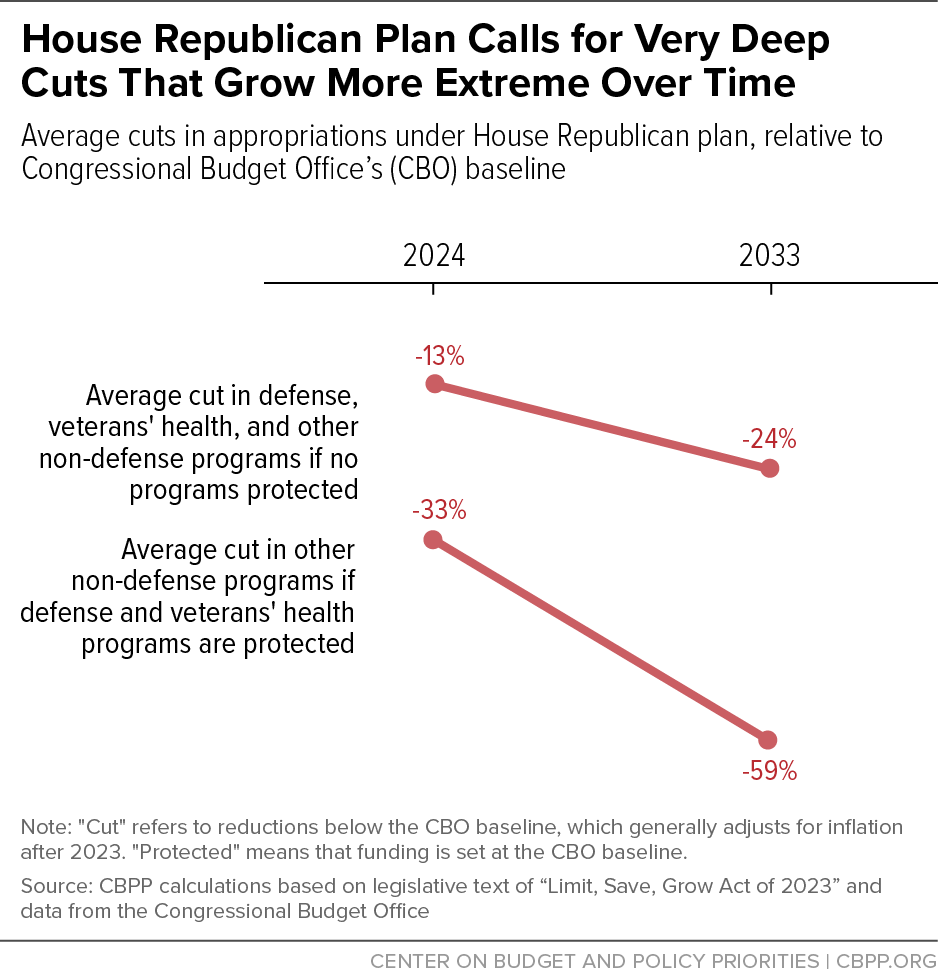BEYOND THE NUMBERS
Note, May 19th, 2023: We've updated this post.
The bill containing House Republicans’ demands for raising the debt ceiling would impose severe cuts amounting to $3.6 trillion over the next ten years, along with the many other harmful changes it would make. The funding cuts would hit a wide swath of vital programs and would grow from bad to beyond extreme: to between 24 and 59 percent in 2033, depending on whether programs such as defense and veterans’ medical care are protected from cuts, as many House Republicans propose.
The new caps will force substantial funding reductions in 2024 and further erode the purchasing power of appropriations in every year through 2033. The affected programs support a wide range of functions and services, such as the armed forces; administration of Social Security and Medicare; medical care for veterans; support for K-12 and college education, Head Start and child care; mental health and substance use treatment; small business assistance; public health programs; clean air and water; medical research; housing assistance for families with low incomes; law enforcement and the courts; and many others.
These programs are often called “discretionary” because their authorizing law gives Congress discretion to set funding levels through the annual appropriations process — in contrast to “mandatory” programs, where funding is determined by the underlying law governing the program.
Under the Republican package, released last week by House Speaker McCarthy, the new caps would roll back overall 2024 funding to the 2022 level, with no increase even to cover rising costs since then. The caps would then grow by 1 percent in each of the next nine years, considerably less than projected inflation. The result would be serious cuts in a wide range of services, starting in 2024 and growing far deeper as the years go on.
Measured relative to Congressional Budget Office (CBO) “baseline” levels — essentially what’s needed to keep pace with inflation — overall funding would be cut by 13 percent in 2024. The cuts would grow steadily from there, reaching 24 percent in 2033 (see chart).
But those would be the average reductions in the overall total. The cuts in some areas would necessarily be larger if Congress decides to lessen the cuts in others — such as defense and veterans’ medical care, a stated preference among many Republicans.
Because the McCarthy bill’s funding caps would apply to total discretionary appropriations, defense and non-defense combined, if Congress decides not to cut defense programs non-defense areas would have to be hit harder. (This is in contrast even to the austere Budget Control Act of 2011, in effect 2012–2021, which set separate limits for defense and non-defense programs.) In particular, if defense is funded at CBO’s baseline (essentially keeping pace with inflation), the overall cut to non-defense — including veterans’ medical care — would be 27 percent in 2024, rising to 49 percent in 2033 relative to the CBO baseline.
The hit to individual programs would be profound. In estimates done in March when House Republicans first announced this general approach, federal agencies analyzed the impact of various cuts to non-defense discretionary programs if Congress protected defense (but not veterans’ health care) from cuts, and cut all other programs by the same percentage.
They found, for example, that in 2024 the cuts would cause 926,000 households to lose Housing Choice Vouchers or project-based rental assistance, which help families with low incomes afford rent; this would cut the programs by roughly one-quarter. They also found that the cut would reduce the maximum Pell Grant that helps students afford college by $1,000; cut the number of children in Head Start by 200,000; and force Social Security field offices to close and staff to be laid off — a catastrophic hit to their ability to serve those applying for or receiving Social Security.
In addition to defense, Congress may want to protect veterans’ medical care from cuts. This program accounts for almost one-sixth of non-defense appropriations, and Congress has understandably sought to provide it with funding to keep up with rising costs and needs. But if both defense and veterans’ medical care are funded at the CBO baseline levels, the cuts to non-defense, non-veterans-health programs would start at 33 percent in 2024 and grow to 59 percent — more than half — in 2033.
(Note these estimates differ somewhat from previous analyses of changes between 2023 and 2024, by us and others; the release of actual legislation with ten years of caps and more detailed information lets us focus on the ten-year, cumulative effects using CBO’s inflation-adjusted baseline.)
In sum, the McCarthy bill’s new caps are extremely austere and would lead to a hollowing out of a host of basic services. They would slash funding for a wide range of federal functions and services — potentially cutting domestic programs by more than half on an inflation-adjusted basis by the end of the ten-year period. Congress should reject this policy and the House Republicans’ approach of using the need to raise the debt ceiling as leverage to force ill-conceived and damaging program cuts — an approach that is irresponsible and dangerous, as we have explained.

